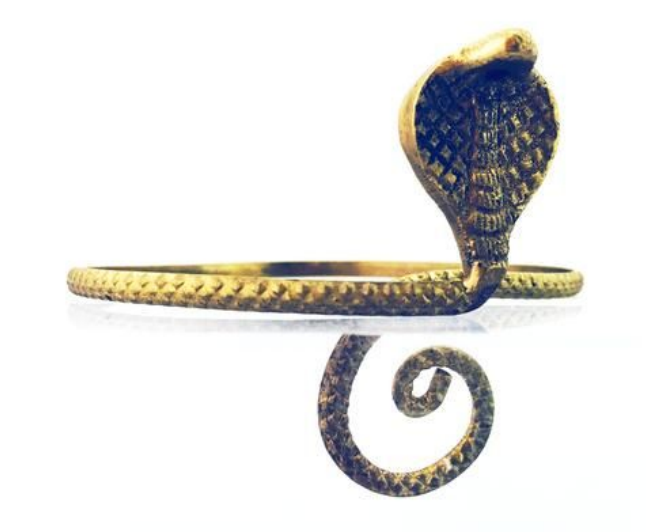
Fashion Flashback: Bracelets by Morgan Watkins
"Fashion Flashback: Bracelets" written by Morgan Watkins
One of the oldest pieces of jewelry known to man is the bracelet. Worn and adored by cultures far and wide, bracelets can be tracked back tens of thousands of years. But how did some of our favorite styles come to be? Read on to learn more about bangles, charm bracelets and other beloved arm candy.
Initially, bracelets were made out of a variety of natural goods such as stone, twigs, feathers, horns, teeth, and even insect secretions. In 2008, archaeologists discovered a stone bangle that could be as old as 70,000 years. Researchers believe that an early human species known as the Denisovans crafted the ancient piece.

(Image from https://www.dailymail.co.uk/sciencetech/article-4753746/Scientists-believe-stone-bracel et-70-000-years-old.html)
Other bangles have been found within tombs and other ancient ruins all over the world, ranging from Mayan stomping grounds to Roman ones. In Indian cultures, glass bangles are customarily worn by brides to represent safety and a prosperous marriage. These glass accessories are worn for life; they’re only broken or removed in themselves with wrist cuffs constructed from leather and metal, while also wearing upper and lower arm cuffs for ornamental reasons. Snake inspired bangles which coiled around the wrist were en vogue, until bracelets lost popularity in the Middle Ages, when Christian and Catholic ideals claimed the wearing of jewelry to be an act of shameful vanity.

(image from www.talkingfashion.net)
This religious mindset humbled individuals around the globe until the Renaissance rolled around. While men were less likely to be seen accessorizing with bracelets at this time, European women insisted on bringing the ornaments back into style around the late 16th and early 17th centuries. Cameo bracelets depicting images of gods, deities, animals, landscapes and more were on trend, and by the Victorian era, so were charm bracelets. Charm bracelets were originally introduced by Egyptians in ancient times. The charms were said to be magical, providing luck and protection to the wearer.

(image from www.talkingfashion.net)
Around 500 BC, Persians and Babylonians also wore charms for their special powers. But it was Queen Victoria, who wore a gold chain adorned with lockets containing portraits her family, who initially revived the wristlet. The charm bracelet became known as jewelry that was not only charming and elegant, but also an accessory that held personal meaning and significance. From that template came new ideas for charm bracelets, like the cha cha, which is adorned with beads rather than traditional charms.

(image from www.talkingfashion.net)
Like Queen Victoria’s charm bracelet, friendship bracelets also carry themes of love and loyalty. Indigenous people from Central and South America are said to be the inventors of the friendship bracelet, which was constructed by weaving together colorful threads, beads, shells and more. The traditional wearing of friendship bracelets is sacred, for the creator puts a considerable amount of love and hard work into the completion of the wristband. Once the bracelet is tied around the receiver’s wrist, they are allotted one wish which will only be granted if the band is worn until it slips off naturally. Removing the bracelet manually is a sign of a failed or broken friendship, and whatever wish the receiver may have made will be forgotten. The return of the friendship bracelet took place during the 70s, when peace, love and anti-war were common social themes and weaving became a fun craft for kids and teens alike.

(image from www.talkingfashion.net)
It was during the 20th century that bracelets, like other pieces of jewelry, became more affordable due to increased production. Lines were more refined and simplified in comparison to earlier designs as Art Deco influenced fashion. Slim, plastic bangles, wide cuffs, dainty chains, and charm bracelets made of gold-plated brass and sterling silver were popular styles worn by women far and wide. Men even started donning bracelets once more, opting for edgy sterling silver chains.

(image from www.talkingfashion.net)
From the Denisovans to the Chloé runway, the bracelet is the 70,000 year old accessory staple that is constantly being made new in fashion.

(Image from http://www.vogue.it/en/shows/show/collections-fall-winter-2018-19/chloe)
References: “History of Bracelets.” Overstock. Overstock.com, Web. “Oldest Obsidian Bracelet Reveals Amazing Craftsmen’s Skills in the Eighth Millennium BC.” Phys.org. Science X Network, 2011. Web. Stewart, Will. “World’s Oldest Known Stone Bracelet Could Rewrite the History of Early Man: 70,000-Year-Old Bangle Suggests Our Ancestors Were Far More Sophisticated than Thought.” Daily Mail. Associated Newspapers Ltd, 2017. Web. Trautmann, Julianne. “Bracelets.” LoveToKnow. LoveToKnow Corp, Web. Wheat, Michele. “All About Friendship Bracelets.” Wristband Resources. Wristband Resources, Web.
